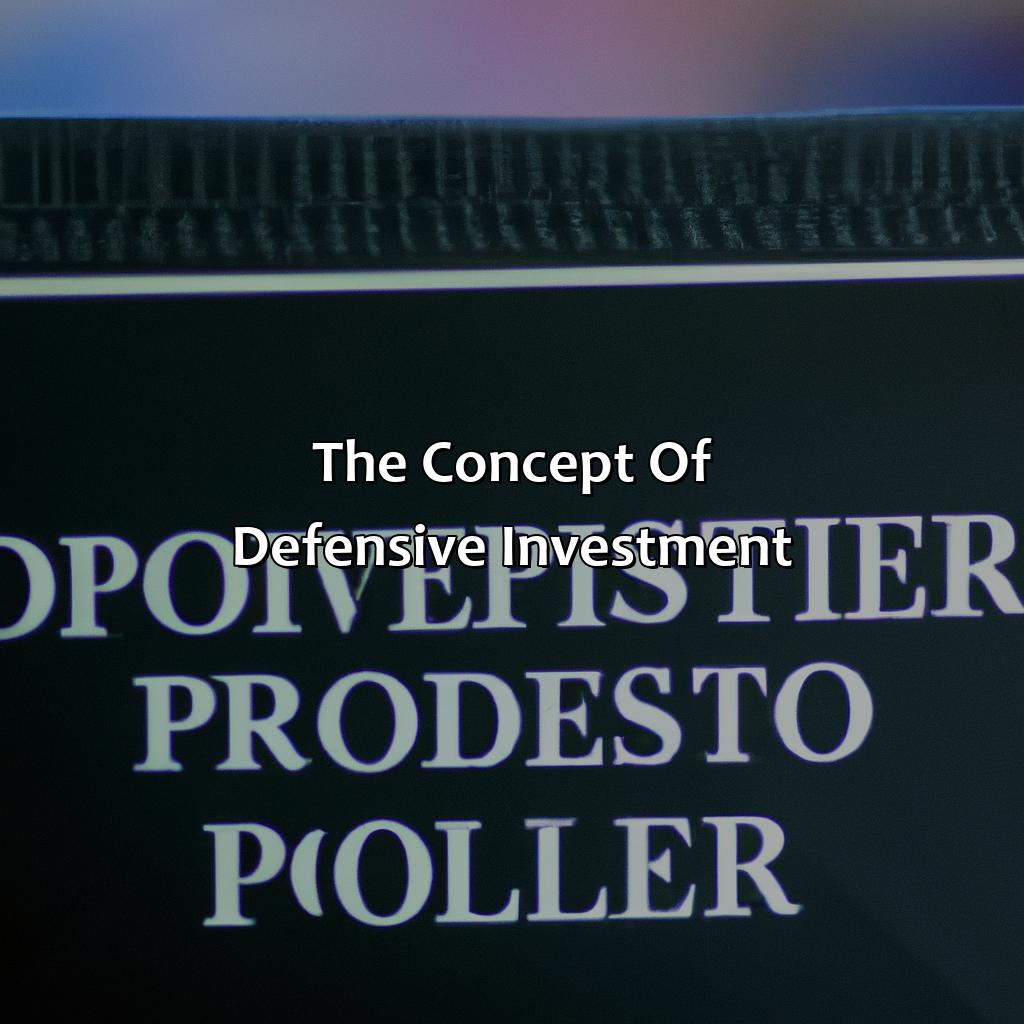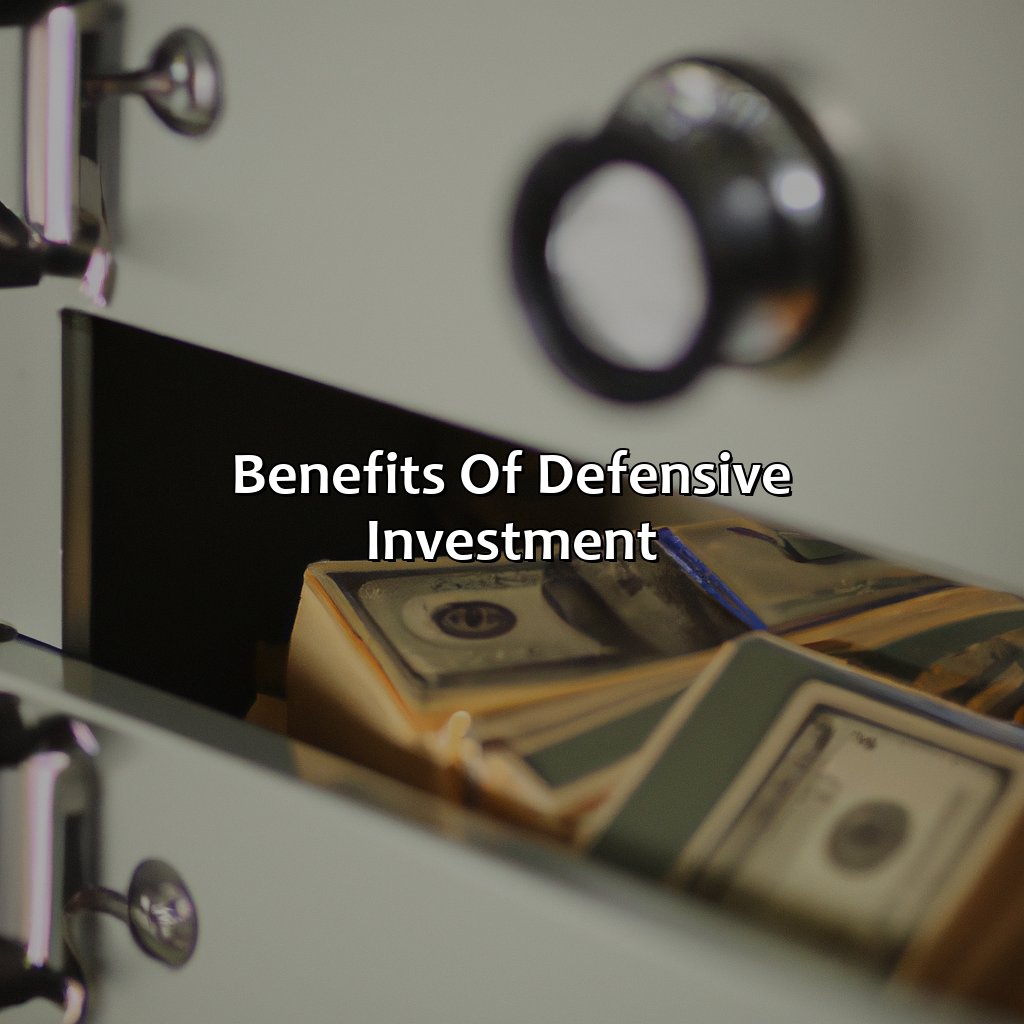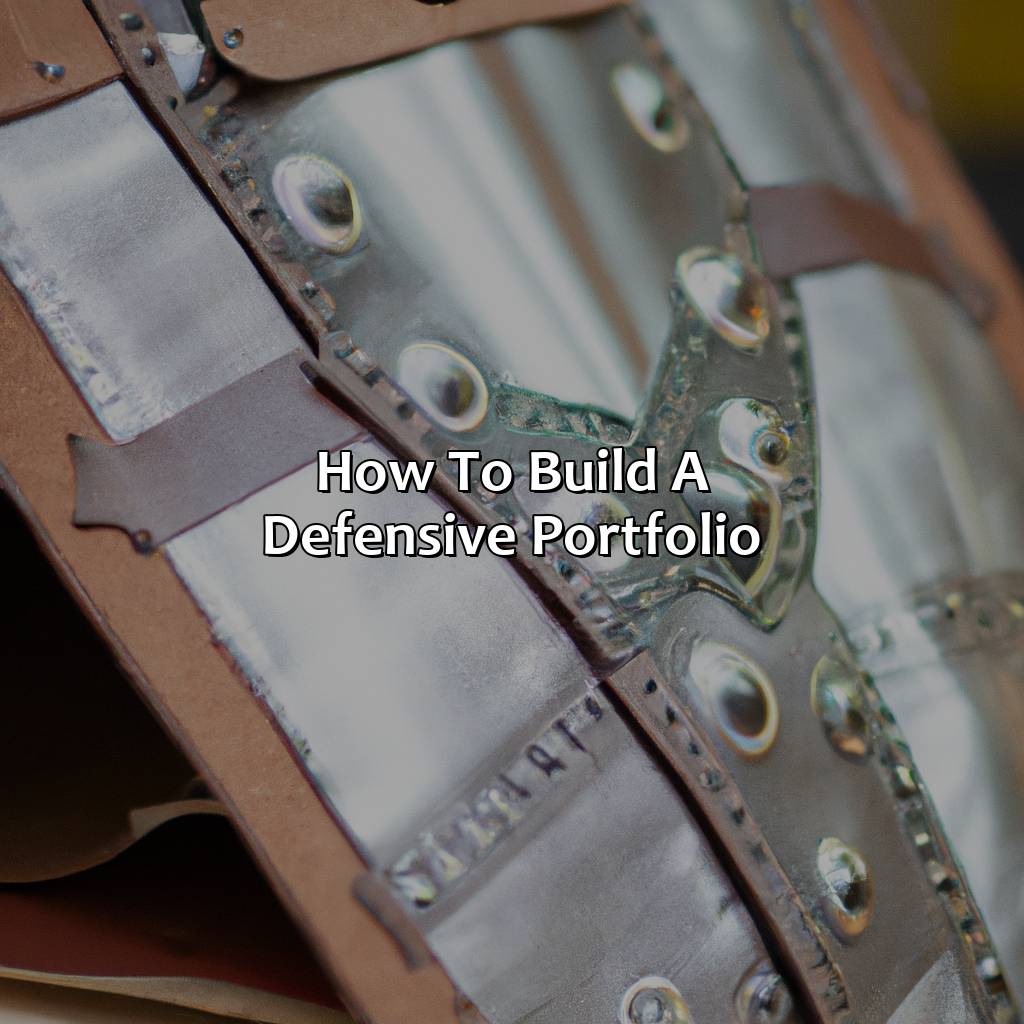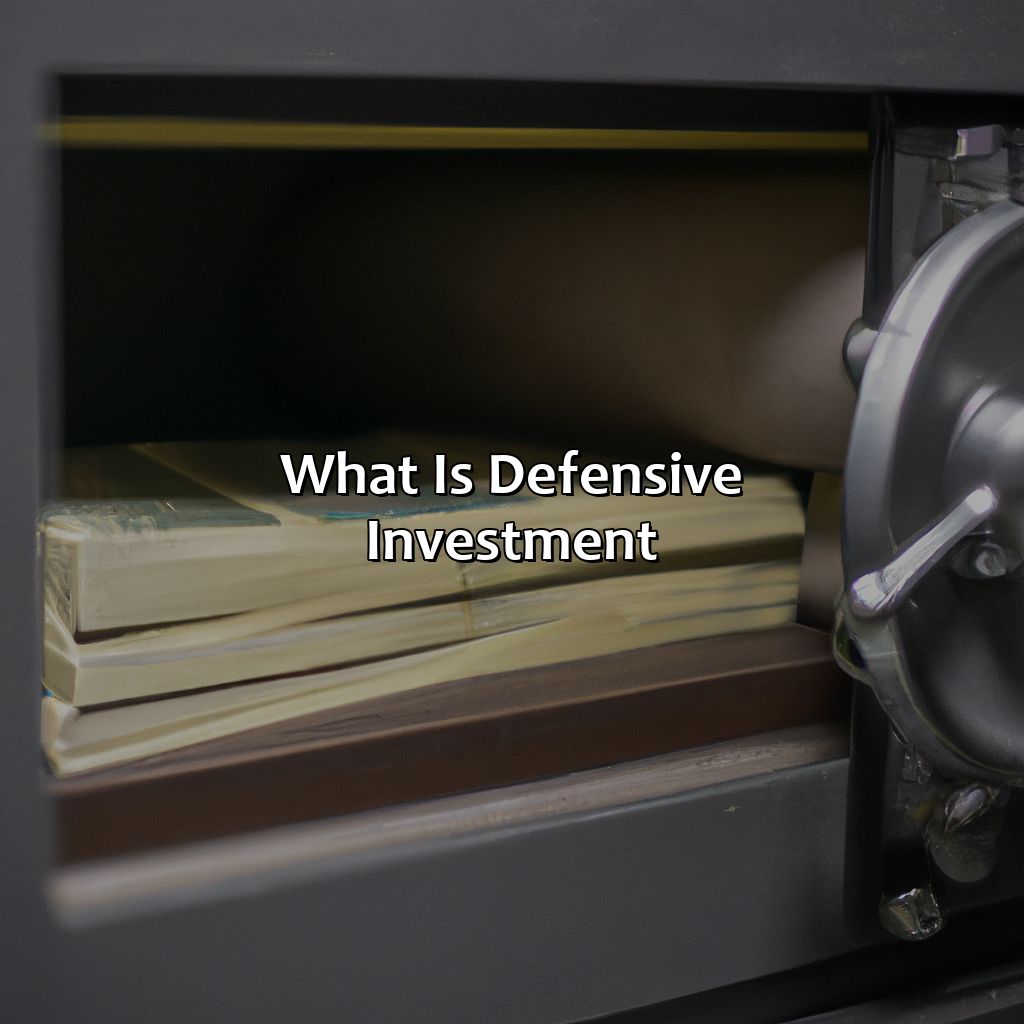What Is Defensive Investment?
Key Takeaway:
- Defensive investment is a strategy used to protect against economic downturns and preserve capital. By diversifying your portfolio with defensive investments like bonds, dividend stocks, cash equivalents, and defensive ETFs, you can reduce volatility and increase stability in your portfolio.
- The benefits of defensive investment include preservation of capital, protection against economic downturns, and less volatility in your portfolio. Defensive investments tend to perform well in times of economic uncertainty, making them a crucial part of a long-term investment plan.
- To build a defensive portfolio, it is important to analyze your investment goals and risk tolerance, diversify your portfolio across different asset classes and sectors, and incorporate defensive investments such as bonds, dividend stocks, cash equivalents, and defensive ETFs. By following these principles, you can achieve long-term financial success and protect your investments from market volatility and economic downturns.
Are you looking to protect your investments and minimize your losses? Defensive investments may be the perfect solution for you. Learn more about what defensive investments are, their advantages, and potential risks.
The Concept of Defensive Investment
Defensive investment involves allocating one’s resources in a manner that mitigates the risk of financial loss during market turmoil. This strategy typically involves investing in assets that are less volatile, such as bonds, dividend-paying stocks, and real estate, which provide steady income and potential capital appreciation. By diversifying one’s portfolio and avoiding speculative investments, investors are better positioned to weather economic downturns and avoid steep losses. Defensive investment is a key component of long-term financial planning, helping to balance risk and return.
It is important to note that defensive investments may not always outperform the broader market during a bull market, but their primary aim is to protect capital during a downturn. According to a report by JPMorgan Asset Management, during the 2008 financial crisis, portfolios with a greater allocation to defensive assets typically fared better and recovered more quickly than those with a higher allocation to more volatile assets.

Image credits: retiregenz.com by James Duncun
Benefits of Defensive Investment
To grasp defensive investing’s advantages, understand Preservation of Capital, Protection against Economic Downturn, and Less Volatility.
This helps make a more reliable and steady investment portfolio. Minimize capital loss risk. Keep investments afloat during times of economic turmoil or market volatility.

Image credits: retiregenz.com by David Arnold
Preservation of Capital
Investors who deploy defensive investment strategies prioritize Preservation of Capital over earning high returns. This method seeks to minimize risk and downturns, enabling investors to maintain their principal investments instead of losing large portions or all of their investment in case the market takes a downturn. Defensive investments often present an ideal opportunity for individuals who seek security in their investments, particularly during economic recessions. By deploying this strategy, investors safeguard themselves against short-term volatility while continuing to earn stable and comparatively lower returns on their investments.
Defensive investments are versatile, with a wide range of securities, including bonds, cash equivalents, real estate investment trusts (REITs), and utility stocks. Individuals who opt for defensive investing may forego opportunities to generate significant profits but mitigate their portfolio risk in return.
It is crucial to note that while defensive investment is not about pursuing the highest possible gains as traditional trading approaches do, it still requires diligent research into the securities available under this category. Investors must identify these unique securities that provide regular and reliable yields while protecting them from market risks.
Ultimately, employing a defensive strategy can yield excellent results when applied correctly. For instance, during the recent covid-19 pandemic crisis that caused unprecedented market uncertainty and volatility globally, defensive investments held steady compared to other riskier types of investment models.
When the economy takes a nosedive, defensive investment is like a security blanket – except it actually works.
Protection against Economic Downturn
Defensive investment minimizes the negative impact of an economic downturn by investing in stable, low-risk assets, such as bonds and consumer staples. These types of investments offer protection when the stock market is volatile. During tough economic times, investors can expect a lower return on investment, but this dip becomes much more manageable with a defensive investment. The strategy provides security amid market uncertainty and represents a more resilient approach for long-term investors.
Unpredictable events, such as recessions or pandemics, make it challenging to predict the stock market. A defensive investment offers peace of mind as it minimizes losses during difficult times. It also allows investors to manage their risk exposure effectively and take advantage of opportunities that arise amidst economic instability.
Pro Tip: Review your portfolio annually to ensure that your investments match your financial goals and risk tolerance level. Consider reallocation of assets if required.
Defensive investing is like having a lifejacket on a stormy sea – it won’t stop the waves, but it will keep you afloat.
Less Volatility
Investing in a defensive portfolio can offer reduced swings in market movements. Opting for a strategy that prioritizes stability ensures less volatility and more stability over time. Maintaining low-risk assets with lower fluctuations allows the investor to avoid sudden market downturns without triggering panic sales.
A defensive investment maintains lower stock allocations, and while fixed-income investments may deliver moderate returns, they provide steady yields during uncertain times. Bonds are among the most common investments in defensive portfolios as their non-correlated nature makes them ideal for market-timing and diversification strategies. Investing in dividend-paying stocks is also an additional option to reduce overall volatility.
Defensive investing allows investors to weather economic and financial storms with fewer risks while benefiting from consistent returns, although it may not always perform as well as growth-oriented portfolios during periods of prolonged economic expansion or bull markets.
According to Forbes, defensive investing can help manage losses better in times of uncertainty, reducing upheavals for the investor who takes a long-term view on their investments.
Defensive investment is like a security blanket – comforting to have, but you hope you never actually need it.
Different Types of Defensive Investment
Maximize returns and minimize risks with defensive investing. Learn about the various types:
- bonds
- dividend stocks
- cash equivalents
- defensive ETFs
Each has unique traits to meet your goals!

Image credits: retiregenz.com by David Duncun
Bonds
Investment in fixed income securities with a predetermined interest rate is an example of investing defensive funds. These securities are also known as debt instruments and can be bought on both primary and secondary markets. Bonds help protect investors from market volatility, but they should understand that the returns in this type of investment are typically lower than equities.
Bonds play a vital role in protecting investors’ portfolios as they offer a fixed return. The risk involved with bonds depends on credit rating; higher-rated bond issuers are safer to invest in than lower-rated ones. Bonds fluctuate based on interest rates and inflation levels, so it is crucial for investors to analyze past trends before investing.
In some instances, bonds do have risks associated with them. For instance, there’s the possibility that the issuing institution could default creating a risk of losing the entire investment. Bond investments vary by maturity length – shorter-term, intermediate-term, or long-term– which determines their risk level.
For instance, Mr.X is ahead of retirement savings target due to sound money managing skills alongside regular contributions towards his employer’s 401k plan over several decades in his career span since he had invested in bonds earlier (5 years). His nest egg includes approximately 90% defensive assets with almost $100K portfolio balance made up of mixed corporate and government bonds; he receives steady monthly payouts which suffice his living expenses for retired life.
Dividends are like hugs from your portfolio- they may not cure all your problems, but they sure do make you feel better.
Dividend Stocks
Investing in companies that pay regular earnings to their shareholders is commonly referred to as ‘yield stocks’. Yield stocks is a type of defensive investment that can provide you with stable income. The value of the stock usually does not change much, but investors get a steady stream of dividends. Companies who offer yield stocks are likely to have grown their business steadily and would prefer to pay some profits back to shareholders than reinvest every dollar.
Yield stocks usually invest in attractive sectors like healthcare, utilities, and consumer goods. These sectors tend to perform better even in times of economic turmoil when other companies face revenue decline or higher debt obligations. Sometimes yield stocks have higher yields than bonds which make them more desirable for many investors.
Investors who look for low-risk investments often go for yield stocks because they are less volatile than growth stocks. They may produce a lower rate of appreciation compared to moderate or aggressive growth stocks, but they offer a degree of safety and predictability combined with potential upside through patiently holding the stock.
According to Investopedia.com, “In 2020 alone, S&P 500-dividend-paying companies paid out over $58 billion more than it cost them to do so“, implying how profitable dividend investing could be.
Keeping your money in a sock under your bed is a cash equivalent, but not necessarily a smart one.
Cash Equivalents
Investments that can be easily converted into cash are known as liquid assets. These include short-term investments like money market funds, treasury bills, and other financial instruments with high liquidity. Cash Equivalents are a type of defensive investment that is highly sought after because of their low risk and quick turnover time.
Cash equivalents offer investors a safe and reliable way to preserve their capital without sacrificing returns. They provide liquidity during tough market conditions when other investment vehicles, such as stocks or bonds, may lose value. Moreover, they are an excellent tool to manage short-term cash needs.
One exceptional advantage of Cash Equivalents is that they offer higher returns than savings accounts while still maintaining relatively high safety standards for investors. This means an investor doesn’t necessarily have to rely solely on the bank’s savings account, which can take longer to mature.
During the 2008 global financial crisis, Cash Equivalents proved their worth when the stock markets crashed worldwide. Many investors who had parked their funds in these instruments were able to withstand the volatility due to economic deceleration in advanced economies such as America and Europe.
Defensive ETFs: Because nothing says safe like putting all your eggs in one never-before-understood basket.
Defensive ETFs
Defensive Exchange-Traded Funds (ETFs) are designed for conservative investors who prefer less exposure to market volatility. These ETFs invest in stocks of companies that have stable cash flow and a track record of paying dividends.
- They consist of utility companies, consumer staples, healthcare, commodities or precious metals.
- They offer capital preservation during economic downturns, unlike other aggressive ETFs.
- They possess fixed-income securities such as bonds or treasury notes with lower default risk.
- They have lower management fees compared to actively managed funds but offer consistent returns.
Investors can consider purchasing defensive ETFs during market uncertainties as they offer quality investments with potential growth prospects even in an economic downturn. These ETFs are considered safer than other investment options but may not produce long-term growth rates as high as the S&P 500.
A few years ago, during one of the worst recessions in history, defensive ETFs emerged as winners and gained popularity among investors worldwide. They tend to outperform when the economy faces turbulence or extreme market conditions.
Protect your portfolio like you protect your heart – with a combination of security and diversification.
How to Build a Defensive Portfolio
To construct a defensive portfolio with the best protection, analyze your investment objectives and risk tolerance. Diversify by choosing various assets and adding defensive investments. We will guide you through building a defensive portfolio in this section, which has sub-sections such as:
- Analyze Investment Goals and Risk Tolerance
- Diversify the Portfolio
- Incorporate Defensive Investments

Image credits: retiregenz.com by James Washington
Analyze Investment Goals and Risk Tolerance
Investors need to carefully evaluate their investment goals and risk tolerance to build a defensive portfolio. Understanding the desired return on investment, time horizon, and ability to handle fluctuations in the market will help determine an appropriate defensive strategy.
Incorporating stocks from sectors that have historically performed well during economic downturns, such as consumer staples and healthcare, can provide stability to a portfolio. Additionally, bonds with high credit ratings and lower volatility can offer diversification and reduce risk.
It is important to note that defensive portfolios may not generate high returns during periods of economic growth and expansion. However, they are designed to protect against significant losses during market downturns.
According to a report by BlackRock Investment Institute, incorporating defensive strategies into one’s portfolio can improve long-term performance through decreased exposure to market volatility.
Don’t put all your eggs in one basket – unless that basket is made of reinforced steel and guarded by a team of ninjas.
Diversify the Portfolio
A diversified investment portfolio is crucial to manage risk and safeguard against market volatility. A range of assets like stocks, bonds, commodities and real estate can provide a balanced mix that can lower the risks associated with individual investments, and help you achieve long-term goals.
By diversifying your portfolio, you can potentially earn better returns and reduce overall risk as risks associated with one investment class may be offset by others. For instance, an increase in bond prices may compensate for a fall in stock prices, leading to a more stable portfolio.
Including international investments can further diversify the portfolio by providing exposure to varying currencies, markets and economies. However, it is essential to ensure that you work with investment advisors or fund managers who have expertise in these markets to make informed decisions.
Pro Tip: Diversification is key but don’t overdo it. Over-diversification leads to dilution of returns and excessive trading costs. Ensure your portfolio is diversified enough to effectively enhance investment goals while minimizing the risk levels involved.
Keep your portfolio as safe as a mother bear protecting her cubs by incorporating defensive investments.
Incorporate Defensive Investments
To make your portfolio defensive, incorporate investments that can withstand turbulent markets. These could include stable equity funds, bonds or treasury bills which are likely to hold their value even during downturns.
Additionally, real estate investment trusts (REITs) or dividend-paying stocks can provide consistent income and serve as a hedge against inflation. Historic data shows that defensive investments tend to outperform riskier assets over the long term.
Investors should also consider diversifying their holdings across multiple sectors and regions to spread out risks. This may entail investing in different asset classes, such as fixed income and equities, both domestically and internationally.
A balanced mix of defensive investments tailored to individual preferences and goals can help investors weather market volatility while still achieving long-term growth. As with any investment strategy, it is important to seek professional advice before making significant changes to one’s portfolio.
Five Facts About Defensive Investment:
- ✅ Defensive investment refers to a strategy of investing in low-risk assets that can provide a steady income and preserve capital. (Source: Investopedia)
- ✅ Examples of defensive investments include bonds, blue-chip stocks, and real estate investment trusts (REITs). (Source: The Balance)
- ✅ Defensive investments are often favored by investors during economic downturns or periods of market volatility. (Source: Forbes)
- ✅ While defensive investments may offer lower returns compared to aggressive or growth investments, they can provide a cushion against market fluctuations and help maintain portfolio stability. (Source: Charles Schwab)
- ✅ Defensive investment strategies should be balanced with growth strategies based on an individual’s risk tolerance, investment goals, and time horizon. (Source: The Balance)
FAQs about What Is Defensive Investment?
What is defensive investment?
Defensive investment is an investment strategy that involves investing in low-risk assets or securities with stable returns. It is designed to protect your capital against market volatility and economic downturns.
What are examples of defensive investments?
Examples of defensive investments include government bonds, treasury bills, high-quality corporate bonds, dividend-paying stocks, utility stocks, and consumer staple stocks.
What are the benefits of defensive investments?
The benefits of defensive investments include protection against market volatility, stable returns, and reduced risk of loss. These investments can also provide a source of income during economic downturns.
What are the drawbacks of defensive investments?
The drawbacks of defensive investments include lower potential returns compared to riskier investments, limited growth potential, and the possibility of losing purchasing power due to inflation.
What are the investment strategies for defensive investments?
The investment strategies for defensive investments include diversification, asset allocation, and investing in defensive sectors such as healthcare, utilities, and consumer staples.
How do I determine if defensive investments are suitable for me?
To determine if defensive investments are suitable for you, consider your risk tolerance, investment goals, and investment timeframe. If you are looking for lower risk and stable returns, defensive investments may be a good option for you.
